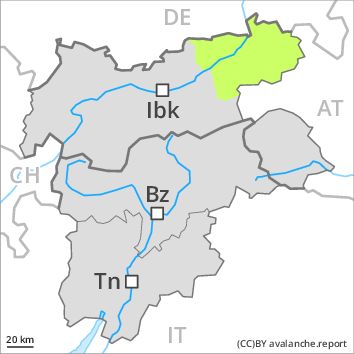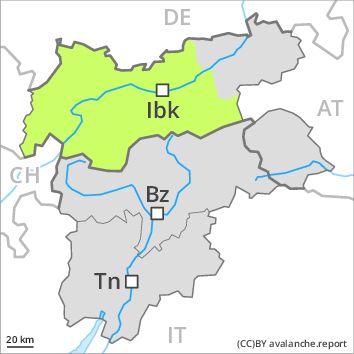Regions
Sexten Dolomites, Val Müstair Alps, Langtaufers, Schnals Ridge, Southern Stubai Alps, Southern Zillertal Alps and High Tauern, Saldurn-Mastaun Ridge, Texel Mountains, Sarntal Alps, Western Pfunderer Mountains, Eastern Pfunderer Mountains, Durreck Range, Western Rieserferner Mountains, Western Deferegger Alps, Ortler Range, Ulten Valley, Venediger Range, Eastern Nonsberger Alps, Eastern Rieserferner Mountains, Northern Dolomites of Fiemme, Glockner Range, Gröden Dolomites, Eastern Deferegger Alps, Prags Dolomites, Schober Mountains, Lienzer Dolomites

Danger level
Danger Level 1 - Low above 2600m
Danger Level 2 - Moderate above 2600m
Avalanche Problem
Gliding snow above 2600m, E-SE-S-SW-W

Caution is to be exercised in areas with glide cracks.
Individual gliding avalanches are possible, even large ones in isolated cases, especially in the regions with a lot of snow below approximately 2600 m. Areas with glide cracks are to be avoided as far as possible.
Fresh wind slabs require caution. The fresh wind slabs are small. Isolated avalanche prone locations are to be found on extremely steep shady slopes at high altitudes and in high Alpine regions and adjacent to ridgelines.
Snowpack
dp 2: gliding snow
The fresh wind slabs have bonded quite well with the old snowpack. The old snowpack will be moist below the tree line.
Tendency
The avalanche danger will persist. The snow sport conditions outside marked and open pistes are generally favourable.
Regions
Brandenberg Alps, Western Kitzbühel Alps, Wilder Kaiser Mountains - Waidring Alps, Eastern Kitzbühel Alps

Danger level
Danger Level 1 - Low
Avalanche Problem
Favourable situation above 2200m

The conditions are favourable.
A little snow is lying. Individual avalanche prone locations for dry avalanches are to be found in particular on extremely steep shady slopes, especially adjacent to ridgelines. Such avalanche prone locations are rare and are easy to recognise.
Snowpack
The snowpack will be stable over a wide area. This applies at high altitude. At low and intermediate altitudes hardly any snow is lying.
Tendency
Low, level 1.
Regions
Weißkugel Range, Western Verwall Mountains, Gurgler Range, Central Stubai Alps, Eastern Verwall Mountains, Northern Zillertal Alps, Allgäu Alps, Silvretta, Samnaun Mountains, Eastern Lechtal Alps - Ammergau Alps, Northern Oetz and Stubai Alps, Mieming Mountains, Western Tuxer Alps, Karwendel Mountains, Eastern Tuxer Alps, Western Lechtal Alps, Central Lechtal Alps, Glockturm Range, Grieskogel Mountains

Danger level
Danger Level 1 - Low
Avalanche Problem
Wind-drifted snow above 2400m, N-NE-E-NW

Wind slabs above approximately 2400 m.
Fresh wind slabs can still be released in some cases in particular on extremely steep shady slopes above approximately 2400 m, in particular adjacent to ridgelines. Avalanches are rather small. Caution is to be exercised in particular in the regions exposed to the foehn wind.
Snowpack
dp 6: cold, loose snow and wind
In isolated cases wind slabs are lying on soft layers. This applies at high altitudes and in high Alpine regions. The old snowpack will be moist below the tree line.
Tendency
The avalanche conditions are favourable.



